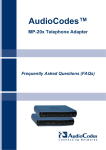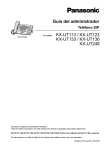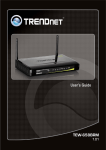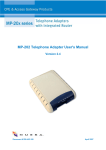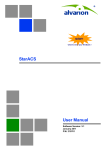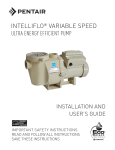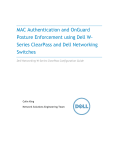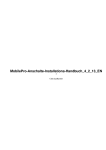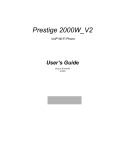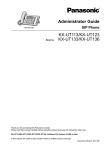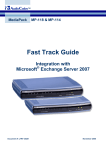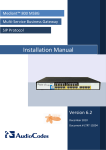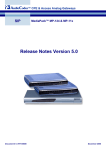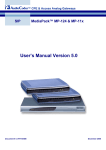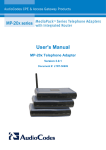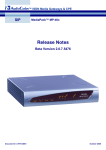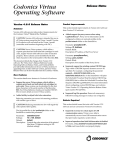Download - AudioCodes
Transcript
AudioCodes CPE & Access Gateway Products MediaPack™ Series Telephone Adapters MP-20x Series with Integrated Router Application Note MP-20x Remote Management Options Version 2.6.x/2.8.0 Revision Date MP-20x Version Comments 1 14 August 2008 2.6.x First edition 2 4 September 2008 2.6.x TR-069 added Application Note Contents Table of Contents 1 Introduction .........................................................................................................7 2 Configuration and Management Tasks .............................................................9 2.1 Configuration Tasks ................................................................................................. 9 2.2 Remote Management Tasks .................................................................................. 10 2.2.1 2.2.2 2.2.3 3 Firmware Upgrade ...................................................................................................10 Status and Performance Monitoring ........................................................................12 Alarms, Notifications and Logging ...........................................................................13 Remote Configuration and Management Interfaces....................................... 15 3.1 Embedded Web Server / Web GUI ........................................................................ 16 3.1.1 3.2 3.2.1 3.2.2 3.2.3 3.3 3.3.3 Security Concerns and Measures ...........................................................................28 Automatic File Download ....................................................................................... 29 3.5.1 3.5.2 3.5.3 3.6 Configuring the MP-20x via SNMP ..........................................................................26 Monitoring the MP-20x via SNMP ...........................................................................26 3.3.2.1 VoIP Monitoring ........................................................................................26 3.3.2.2 Network Interfaces and System Monitoring .............................................27 Security Concerns and Measures ...........................................................................27 Syslog .................................................................................................................... 28 3.4.1 3.5 Configuring MP-20x via TR-069 and TR-104 ..........................................................18 3.2.1.1 Configuring the WAN Interface ................................................................18 3.2.1.2 Configuring the LAN Interface ..................................................................19 3.2.1.3 Configuring VoIP via TR-104 ...................................................................20 3.2.1.4 Upgrading Firmware via TR-069 ..............................................................21 Monitoring the MP-20x Status via TR-069 and TR-104 ..........................................22 3.2.2.1 Device Information ...................................................................................22 3.2.2.2 WAN Status ..............................................................................................22 3.2.2.3 LAN Status ...............................................................................................23 3.2.2.4 VoIP Status via TR-104 ............................................................................23 Security Concerns and Measures ...........................................................................24 SNMP ..................................................................................................................... 25 3.3.1 3.3.2 3.4 Security Concerns and Measures ...........................................................................16 TR-069 and TR-104 CPE WAN Management Protocol ......................................... 17 Firmware File Download ..........................................................................................29 Configuration File Download ...................................................................................29 Security Concerns and Measures ...........................................................................30 Telnet CLI.............................................................................................................. 31 3.6.1 Version 2.6.x/2.8.0 Security Concerns and Measures ...........................................................................31 3 September 2008 MP-20x Series List of Figures Figure 2-1: Remote Management Interfaces............................................................................................9 Figure 2-2: Firmware Upgrade Mechanisms ..........................................................................................11 Figure 3-1: TR-069 CPE WAN Management Protocol ...........................................................................17 Figure 3-2: SNMP Network Architecture ................................................................................................25 List of Tables Table 2-1: Main MP-20x Configuration Parameter Groups ....................................................................10 Table 2-2: Status and Performance Monitoring Parameters ..................................................................12 Table 2-3: Severity of Logged Events ....................................................................................................13 Table 2-4: Notifications and Logged Events...........................................................................................13 Table 3-1: Operations per Configuration/Management Interface ...........................................................15 Table 3-2: InternetGatewayDevice.WANDevice.2.WANConnectionDevice.2.WANIPConnection.2 .....18 Table 3-3: InternetGatewayDevice.LANDevice.2.LANEthernetInterfaceConfig. ...................................19 Table 3-4: InternetGatewayDevice.LANDevice.1.LANHostConfigManagemen.....................................19 Table 3-5: InternetGatewayDevice.Services.VoiceService.1.Capabilitie ...............................................20 Table 3-6: InternetGatewayDevice.Services.VoiceService.1.Capabilities.Codecs. ...............................20 Table 3-7: InternetGatewayDevice.Services.VoiceService.1.VoiceProfile. ...........................................21 Table 3-8: InternetGatewayDevice.Services.VoiceService.1.VoiceProfile.1.SI .....................................21 Table 3-9: InternetGatewayDevice.DeviceInf .........................................................................................22 Table 3-10: InternetGatewayDevice.WANDevice.2.WANConnectionDevice.2.WANIPConnection.2.Stat22 Table 3-11: InternetGatewayDevice.LANDevice.1.LANEthernetInterfaceConfig.1.Stat ........................23 Table 3-12: InternetGatewayDevice.Services.VoiceService.1.VoiceProfile.1.Line.1.Stats. ..................23 Table 3-13: Information Elements Available via MIB-II ..........................................................................27 Remote Management Options 4 Document #: LTRT-55201 Application Note Notices Notice This document describes the remote management options for AudioCodes MP-20x Telephone Adapter. Information contained in this document is believed to be accurate and reliable at the time of printing. However, due to ongoing product improvements and revisions, AudioCodes cannot guarantee accuracy of printed material after the Date Published nor can it accept responsibility for errors or omissions. Before consulting this document, check the corresponding Release Notes regarding feature preconditions and/or specific support in this release. In cases where there are discrepancies between this document and the Release Notes, the information in the Release Notes supersedes that in this document. Updates to this document and other documents can be viewed by registered customers at http://www.audiocodes.com/support. © Copyright 2008 AudioCodes Ltd. All rights reserved. This document is subject to change without notice. Date Published: Sep-23-2008 Tip: Date Printed: Sep-25-2008 When viewing this manual on CD, Web site or on any other electronic copy, all cross-references are hyperlinked. Click on the page or section numbers (shown in blue) to reach the individual cross-referenced item directly. To return back to the point from where you accessed the crossreference, press the ALT and ◄ keys. Trademarks AC logo, Ardito, AudioCoded, AudioCodes, AudioCodes logo, CTI², CTI Squared, InTouch, IPmedia, Mediant, MediaPack, MP-MLQ, NetCoder, Netrake, Nuera, Open Solutions Network, OSN, Stretto, 3GX, TrunkPack, VoicePacketizer, VoIPerfect, What's Inside Matters, Your Gateway To VoIP, are trademarks or registered trademarks of AudioCodes Limited. All other products or trademarks are the property of their respective owners. WEEE EU Directive Pursuant to the WEEE EU Directive, electronic and electrical waste must not be disposed of with unsorted waste. Please contact your local recycling authority for disposal of this product. Customer Support Customer technical support and service are provided by AudioCodes’ Distributors, Partners, and Resellers from whom the product was purchased. For Customer support for products purchased directly from AudioCodes, contact [email protected]. Abbreviations and Terminology Each abbreviation, unless widely used, is spelled out in full when first used, and only Industry standard terms are used throughout this manual. Version 2.6.x/2.8.0 5 September 2008 MP-20x Series Related Documentation Document # LTRT-505xx LTRT-506xx LTRT-504xx Remote Management Options Manual Name MP-20x Telephone Adapter Release Notes MP-20x Telephone Adapter User's Manual MP-20x Telephone Adapter Quick Installation Guide 6 Document #: LTRT-55201 Application Note 1 Remote Management Options Introduction The MP-20x was designed to be mass-deployed by carriers and service providers. One of the keys to guarantee end-user satisfaction and true toll-quality service in mass field deployment is comprehensive remote configuration and management capabilities: “Out-of-the-box” installation at user’s site without any manual configuration Automatic and remote configuration updates Automatic and remote firmware updates Remote diagnosis of problems reported by the user Remote collection of statistical information regarding the quality of the service Remote notifications of service problems This Application Note provides a high-level overview of all the remote management and configuration options offered by the MP-20x series product line. The document is divided into two parts: The first part (Section 2) describes the configuration and management tasks, i.e., what must be configured and managed in the MP-20x (the “what”). The second part (Section 3) describes the available configuration and management interfaces and methods (the “how”). Version 2.6.x/2.8.0 7 September 2008 MP-20x Series Reader’s Notes Remote Management Options 8 Document #: LTRT-55201 Application Note Remote Management Options 2 Configuration and Management Tasks 2.1 Configuration Tasks By default, the MP-20x is provided by AudioCodes with factory default settings, which are common to all MP-20x devices (except for the MAC address). The factory settings allows the user to connect to the MP-20x’s embedded Web server from the LAN interface. By default, the WAN interface is configured for DHCP (i.e., automatically obtains its IP address from a DHCP server). In the case of PPPoE or other Internet dialers, this default configuration will not allow the MP-20x to connect to the Internet. The default configuration does not include any VoIP service provider settings (such as a SIP proxy). In some cases, AudioCodes can ship MP-20x devices that are pre-configured with some customer-specific parameters. This set of parameters is usually defined as the new “factory settings” for this specific customer. The MP-20x's factory default settings and the current configuration running on the MP-20x are stored on the MP-20x's non-volatile flash memory. The current configuration can be remotely updated using several configuration interfaces (as shown in Figure 2-1): HTTP-based Web server SNMP TR-069 Configuration file upload/download Figure 2-1: Remote Management Interfaces All configuration interfaces access the same internal configuration repository. The configuration file represents the complete set of MP-20x configuration parameters. Specific configuration interfaces (e.g. SNMP and TR-069) might support access only to a sub-set of these configuration parameters. At any time, the factory settings can be restored using the Web interface or by pressing on the Restore Defaults push-button while the MP-20x is being powered up. Version 2.6.x/2.8.0 9 September 2008 MP-20x Series The table below lists the main MP-20x configuration parameter groups: Table 2-1: Main MP-20x Configuration Parameter Groups Group Description VoIP Parameters relating to the VoIP functionality of the MP-20x (e.g. analog interface, SIP or MGCP signaling, voice and fax, media streaming) WAN Interface The main WAN Internet connection (this group is also referred to as the “Quick Setup”). Network Connections Configuration of all network connections (LAN and WAN), including advanced connections such as VLANs. Security Parameters relating to the MP-20x internal firewall. QoS Configuration of Quality of Service parameters such as priorities and traffic shaping. System / Advanced Configuration of system parameters such as Remote Update and Remote Access and advanced parameters such as Dynamic DNS, UPnP. The following list represents a typical set of parameters that a service provider may want to configure: Remote access and/or automatic firmware and configuration update parameters VoIP configuration: SIP proxy, line settings (User IP, Password) QoS parameters (e.g. traffic shaping) 2.2 Remote Management Tasks 2.2.1 Firmware Upgrade Service providers require the ability to update the MP-20x's firmware in the field (e.g. in case of maintenance releases or releases that support new required features). The process is required to be: Automatic, allowing mass update Robust and fail-safe The MP-20x's firmware is stored in the non-volatile flash memory. The MP-20x's flash memory is capable of storing a recovery firmware that ensures a fail-safe operation (even if the user unplugs the power during the firmware burning process). The MP-20x's firmware can be upgraded using one of the following mechanisms (refer to Figure 2-2): The new firmware can be “pushed” (uploaded) to the MP-20x, using the embedded Web server The new firmware can be “pulled” (downloaded) by the MP-20x from a remote HTTP, FTP, or TFTP server Remote Management Options 10 Document #: LTRT-55201 Application Note Remote Management Options Figure 2-2: Firmware Upgrade Mechanisms The remote firmware download process can be triggered by one of the following: MP-20x checks for a new firmware upon MP-20x restart MP-20x periodically checks for a new firmware Manual trigger using CLI, TR-069, SNMP, or Web Note: Unless forced, the MP-20x downloads and upgrades to the new firmware only if its version number is higher than the current firmware version. The version number is not taken from the image file name, but from the header of the image file. Version 2.6.x/2.8.0 11 September 2008 MP-20x Series 2.2.2 Status and Performance Monitoring The ability to remotely monitor the status of the MP-20x is critical to the service provider, who wants to support users without having to send a technician on site (avoiding the “truck roll”). The service provider may want to know the current status of the MP-20x (e.g. is it registered to the SIP proxy, is the phone off-hook) or some statistical information (e.g. average packet loss during a call). The MP-20x maintains a set of status and performance information internally. This information (or parts of it) can be retrieved via the different management interfaces (e.g. Web, SNMP, or TR-069). The table below describes the status and performance monitoring (statistical) information available in the MP-20x, divided to the main groups. Table 2-2: Status and Performance Monitoring Parameters Group VoIP Status and Performance Monitoring Parameters Current status information per line: Phone state Registration status Source, codec and type of current call Packet loss, jitter and delay of current call Statistical (min, max, average) information*: Network Connections Packet loss, jitter and delay Out-of-service (e.g. no registration) time Call establishment time (INVITE to OK) Current status information per interface: Connection status Allocated IP address Received and transmitted packets Statistical (min, max, average) information*: System Out-of-service (e.g. link down) time Traffic statistics (sent / received bytes, errors) Software version information Hardware version information System Up time * Available from version 2.8.0 Remote Management Options 12 Document #: LTRT-55201 Application Note 2.2.3 Remote Management Options Alarms, Notifications and Logging Instead of periodically polling the MP-20x to obtain its current status, the service provider may want the MP-20x to notify abnormal events or to send regular reports to a logging server. Both options are supported by the MP-20x from version 2.8.0. Table 2-4 shows what interfaces are relevant for alarms and notifications. Note that the terms Alarm and Notification represent the same thing. The difference between alarm/notification and logging is that an alarm is normally used to represent an abnormal event (e.g. registration error), while logged events can represent either regular events (e.g. end of call) or abnormal events. The table below shows the event severity levels defined in the MP-20x. Typically, events with severity of Error or Emergency are notified in addition to being logged. Table 2-3: Severity of Logged Events Severity Description Debug Debug-level messages. Notice Normal but significant condition. Notices requiring attention at a later time. Nonerror conditions that might require special handling. Error Recoverable / temporary error condition. Emergency System is unusable. The most severe messages that prevent continuation of operation, such as immediate system shutdown. The table below shows the available notifications and logged events. Table 2-4: Notifications and Logged Events Group VoIP Notifications and Logged Events Notifications: Registration error or timeout Logged Events: Network Connections End of call (Call Detail Record logging) SIP messages logging (optional – for debugging) Notifications: Security Logged Events: System Connection up / down Security log (configurable) Notifications: System restart Firmware / configuration update Logged Events: Version 2.6.x/2.8.0 Debug-level logging (optional) 13 September 2008 MP-20x Series Reader’s Notes Remote Management Options 14 Document #: LTRT-55201 Application Note 3 Remote Management Options Remote Configuration and Management Interfaces The following interfaces are available on the MP-20x for remote configuration and management: Web server (GUI) over http / https (refer to Section 3.1 on page 16) TR-069 and TR-104 refer to Section 3.2 on page 17) SNMP (refer to Section 3.3 on page 25) Syslog (refer to Section 3.4 on page 28) Firmware or configuration file download via HTTP/ HTTPS / FTP / TFTP (refer to Section 3.5 on page 29) CLI over Telnet / SSH (refer to Section 3.6 on page 31) The table below lists the possible operations over these different interfaces: Table 3-1: Operations per Configuration/Management Interface Operation Web GUI TR-069 SNMP Syslog File D/L CLI Configuration Update Yes Yes Yes* No Yes Yes Firmware Upgrade Yes Yes Yes* No Yes Yes Status Monitoring Yes Yes* Yes* No No Yes Performance Monitoring Yes* Yes* Yes* Yes* No Yes* Alarms and Notifications No Yes* Yes* Yes No No Debugging and Diagnostics Yes No No Yes No Yes * Available only from Release 2.8.0 Service providers can choose to combine several management interfaces, for example, Automatic file download for configuration and firmware updates plus SNMP for alarms. Version 2.6.x/2.8.0 15 September 2008 MP-20x Series 3.1 Embedded Web Server / Web GUI The MP-20x provides an embedded Web server with a rich Graphical User Interface (GUI). The Web server can be accessed from the local LAN interface (e.g. by the home user) or from the WAN interface (e.g. by the service provider support personnel). The Web GUI provides easy and intuitive configuration of all MP-20x parameters (i.e., VoIP, network interfaces, security, QoS and advanced system settings). In addition, the Web GUI provides status monitoring pages, diagnostic pages and enabled firmware upgrade. Typically, service providers do not want to configure each MP-20x manually and therefore, they do not use the Web server in live deployments. However, the Web server is still useful for: 3.1.1 Trying different configurations in the lab during the integration phases Creating mass-configuration template files Debugging special customer problems (by accessing the Web server from the WAN interface) Security Concerns and Measures Since the Web server allows all configuration and management operations, it is important to protect it. The following security measures are available: The Web server is user and password protected. Several users can be defined. A special user with limited-access (only to the Quick Setup) can be defined. The access to the Web server can be blocked from the WAN and/or LAN interfaces. Access to the Web server can be limited to specific IP addresses. Secured HTTP (HTTPS) is supported. It is possible to enable HTTPS-only, if required. The HTTP and/or HTTPS port can be modified (from the default 80 and 8080). Remote Management Options 16 Document #: LTRT-55201 Application Note 3.2 Remote Management Options TR-069 and TR-104 CPE WAN Management Protocol TR-069 is a relatively new protocol for managing CPE devices over the WAN interface. The standard is published by the DSL Forum. TR-069 runs over SOAP/HTTP and enables device configuration, management (including firmware upgrade), and status monitoring. TR-104 is an extension of TR-069 for VoIP configuration and monitoring. TR-069 requires a special server on the service provider’s side, called an Auto Configuration Servers (ACS). The TR standards are published by the DSL forum: TR-069: http://www.broadband-forum.org/technical/download/TR-069.pdf TR-104: http://www.broadband-forum.org/technical/download/TR-104.pdf Figure 3-1: TR-069 CPE WAN Management Protocol Notes: Version 2.6.x/2.8.0 • The MP-20x was tested for interoperability with two ACS vendors – Motive and FriendlyTR69. Working with other ACS types may require specific interoperability effort. • Additional TR-069 and TR-104 parameters will be implemented in the MP20x in version 2.8.0. • The parameter values in the subsequent tables are sample values only taken from an ACS. 17 September 2008 MP-20x Series 3.2.1 Configuring MP-20x via TR-069 and TR-104 TR-069 allows basic configuration of the MP-20x. The configuration is defined in a hierarchical tree-like structure according to the TR-069 standard. 3.2.1.1 Configuring the WAN Interface Table 3-2: InternetGatewayDevice.WANDevice.2.WANConnectionDevice.2.WANIPConnection.2 Parameter Value AddressingType DHCP ConnectionStatus Connected ConnectionType IP_Routed DefaultGateway 10.16.0.1 DNSEnabled true DNSOverrideAllowed true DNSServers 10.1.1.11,10.1.1.10 Enable true ExternalIPAddress 10.16.2.25 MaxMTUSize 1500 Name WAN Ethernet NATEnabled true PortMappingNumberOfEntries 0 PossibleConnectionTypes IP_Routed RouteProtocolRx Off RSIPAvailable false ShapingRate -1 SubnetMask 255.255.0.0 Uptime 792 Remote Management Options 18 Document #: LTRT-55201 Application Note 3.2.1.2 Remote Management Options Configuring the LAN Interface Table 3-3: InternetGatewayDevice.LANDevice.2.LANEthernetInterfaceConfig. Parameter Value Enable true MACAddress 00:90:8F:09:93:DC MaxBitRate 100 Status Disabled Table 3-4: InternetGatewayDevice.LANDevice.1.LANHostConfigManagemen Parameter Value AllowedMACAddresses DHCPLeaseTime 3600 DHCPRelay false DHCPServerEnable true DNSServers 192.168.1.1 DomainName home IPRouters 192.168.1.1 MaxAddress 192.168.1.254 MinAddress 192.168.1.1 SubnetMask 255.255.255.0 Version 2.6.x/2.8.0 19 September 2008 MP-20x Series 3.2.1.3 Configuring VoIP via TR-104 Table 3-5: InternetGatewayDevice.Services.VoiceService.1.Capabilitie Parameter Value ButtonMap DSCPCoupled EthernetTaggingCoupled FaxPassThrough FaxT38 MaxLineCount MaxProfileCount MaxSessionCount MaxSessionsPerLine ModemPassThrough NumberingPlan PSTNSoftSwitchOver Regions RingGeneration RTCP RTPRedundancy SignalingProtocols SIP SRTP ToneGeneration VoicePortTests Table 3-6: InternetGatewayDevice.Services.VoiceService.1.Capabilities.Codecs. Parameter Value Codec G.729 EntryID 1 PacketizationPeriod 60,40,30,20,10 Remote Management Options 20 Document #: LTRT-55201 Application Note Remote Management Options Table 3-7: InternetGatewayDevice.Services.VoiceService.1.VoiceProfile. Parameter Value DTMFMethod rfc2833 Enable Enabled Name Line 1 300 NumberOfLines 1 Table 3-8: InternetGatewayDevice.Services.VoiceService.1.VoiceProfile.1.SI Parameter Value OutboundProxy OutboundProxyPort 5060 ProxyServer 10.33.4.204 ProxyServerPort 5060 ProxyServerTransport udp RegisterExpires 3600 RegistrarServerTransport UDP UserAgentPort 5060 UserAgentTransport UDP 3.2.1.4 Upgrading Firmware via TR-069 TR-069 contains a built-in mechanism for CPE device firmware upgrade. Version 2.6.x/2.8.0 21 September 2008 MP-20x Series 3.2.2 Monitoring the MP-20x Status via TR-069 and TR-104 The service provider can monitor the status of the MP-20x via TR-069 and TR-104. 3.2.2.1 Device Information Table 3-9: InternetGatewayDevice.DeviceInf Parameter Value Description Jan 1 00:05:47 2003 Command Line Interface Warning CLI 0x101d26f8 got a string containing a non char 22 character DeviceLog HardwareVersion Manufacturer AudioCodes ManufacturerOUI 00908f ModelName MP202 ProductClass MP20X ProvisioningCode SerialNumber 12345 SoftwareVersion 4.10.4.5.2 SpecVersion 1.0 UpTime 785 3.2.2.2 WAN Status Table 3-10: InternetGatewayDevice.WANDevice.2.WANConnectionDevice.2.WANIPConnection.2.Stat Parameter Value EthernetBytesReceived 1025286 EthernetBytesSent 1686314 EthernetPacketsReceived 2991 EthernetPacketsSent 2867 Remote Management Options 22 Document #: LTRT-55201 Application Note 3.2.2.3 Remote Management Options LAN Status Table 3-11: InternetGatewayDevice.LANDevice.1.LANEthernetInterfaceConfig.1.Stat Parameter Value BytesReceived 0 BytesSent 0 PacketsReceived 0 PacketsSent 0 3.2.2.4 VoIP Status via TR-104 Table 3-12: InternetGatewayDevice.Services.VoiceService.1.VoiceProfile.1.Line.1.Stats. Parameter Value ResetStatistics PacketsSent PacketsReceived BytesSent BytesReceived PacketsLostOverruns Underruns IncomingCallsReceived IncomingCallsAnswered IncomingCallsConnected IncomingCallsFailed OutgoingCallsAttempted OutgoingCallsAnswered OutgoingCallsConnected OutgoingCallsFailed CallsDropped TotalCallTime ServerDownTime ReceivePacketLossRate FarEndPacketLossRate ReceiveInterarrivalJitter FarEndInterarrivalJitter RoundTripDelay Version 2.6.x/2.8.0 23 September 2008 MP-20x Series Parameter Value AverageReceiveInterarrivalJitter AverageFarEndInterarrivalJitter AverageRoundTripDelay 3.2.3 Security Concerns and Measures The CPE WAN Management Protocol is designed to allow a high degree of security in the interactions that use it. The CPE WAN Management Protocol is designed to prevent tampering with the transactions that take place between a CPE and ACS, provide confidentiality for these transactions, and allow various levels of authentication. The following security mechanisms are incorporated in this protocol: The protocol supports the use of SSL/TLS for communications transport between CPE and ACS. This provides transaction confidentiality, data integrity, and allows certificate-based authentication between the CPE and ACS. The HTTP layer provides an alternative means of CPE authentication based on shared secrets. Remote Management Options 24 Document #: LTRT-55201 Application Note 3.3 Remote Management Options SNMP Simple Network Management Protocol (SNMP) is used in network management systems to configure and monitor network-attached devices. SNMP is an IETF standard defined by RFC 1157, 1441 and additional RFCs for specific Management Information Base (MIBs). The MP-20x contains an embedded SNMP agent and supports SNMPv1, SNMPv2 and partially supports SNMPv3. For monitoring of the network interfaces, the standard SNMP MIB-II (RFC 1213) is supported. For more options, a proprietary MIB will be defined (for SW version 2.8.0) by AudioCodes for the MP-20x product line – the acMP20x MIB. The MIB is divided to the following sections: acMP20xConfig: for changing the MP-20x's configuration acMP20xStatus: for monitoring the MP-20x's status acMP20xAlarms: for receiving notifications (alarms) from the MP-20x The figure below shows the SNMP network architecture: Figure 3-2: SNMP Network Architecture Version 2.6.x/2.8.0 25 September 2008 MP-20x Series 3.3.1 Configuring the MP-20x via SNMP The acMP20xConfig MIB section is structured in a similar hierarchy as the MP-20x's Web GUI. Each parameter in the MIB has a matching parameter in the Web GUI and a matching parameter in the gateway’s configuration file. The MIB file defines the valid range and the default value for each parameter. Typically, the customer will integrate the MP20x MIB into the customer's Network Management System (NMS) to automate the configuration process. Notes: 3.3.2 • For SW version 2.8.0, only the VoIP parameters and the Quick Setup parameters are defined. Other parameters (e.g. Security, QoS) must be configured in other methods or using a special generic set object in the MP20x MIB (acMP20xConfigParamPath/ acMP20xConfigParamValue). • A special MIB object is defined to allow MP-20x firmware upgrade triggered by SNMP. The object acMP20xRemoteUpdate triggers a remote upgrade from the SNMP-configured URL. Monitoring the MP-20x via SNMP SMNP can be used to monitor the status of the MP-20x. VoIP-related monitoring is performed via the proprietary MIB acMP20x. Other parameters are available in the standard MIB-II. 3.3.2.1 VoIP Monitoring The acMp20xStatus section allows the service provider to get the current MP-20x status. The list below shows the available objects. acMP20xStatus acMP20xStatusVoIP acMP20xStatusVoIPLinesTable acMP20xLinePhoneState – on-hook / off-hook / ringing acMP20xLineRegistrationState – not registered / registered / registration error acMP20xLineCallsTable acMP20xCallOrigine – Incoming / outgoing acMP20xCallRemoteNumber – Remote phone number acMP20xCallRemoteID – Remote SIP ID acMP20xCallDuration – Call duration in ms acMP20xCallType – Voice/Fax/Modem acMP20xCallEncoder – Tx codec type acMP20xCallDecoder – Rx codec type acMP20xCallPacketsSent – Number of RTP packets sent acMP20xCallPacketsReceived – Number of RTP packets sent acMP20xCallBytesSent – Number of payload bytes sent acMP20xCallBytesReceived – Number of payload bytes received acMP20xCallPacketsLost – Number of packets lost Remote Management Options 26 Document #: LTRT-55201 Application Note Remote Management Options acMP20xCallLostPercentage – Packet loss percentage acMP20xCallJitter – Average call jitter in ms acMP20xCallRoundTripDelay – Average call round-trip delay in ms 3.3.2.2 Network Interfaces and System Monitoring Status monitoring of the system and network interfaces can be done via the standard MIBII (iso(1).org(3).dod(6).internet(1).mgmt(2).mib-2(1)). The following table shows some of the information elements available via MIB-II: Table 3-13: Information Elements Available via MIB-II Section system interfaces Available Information Description Version Information Up-time Information per network interface: Description Type Speed MAC address Traffic statistics Errors ip Assigned IP addresses and IP-related parameters icmp, udp, tcp Transport-protocol specific statistical information ifMIB Information about network interfaces per RFC 2233 3.3.3 Security Concerns and Measures Since SNMP allows write-access to configuration parameters, it is important to protect this interface. The following security measures are available: A community string (password) can be defined for read-only access and for read/write access. It is possible to limit access to SNMP to a trusted peer (single IP address or a range of addresses). SNMPv3 provides an significant security improvement over SNMPv1/2. Version 2.8.0 will support SNMPv3 and will allow the service provider to configure SNMPv3 security parameters. SNMP traffic can be allowed over an IPSec secured connection – check availability with AudioCodes. Version 2.6.x/2.8.0 27 September 2008 MP-20x Series 3.4 Syslog Syslog is a standard protocol for reporting and logging of messages over IP network and is defined by RFC 3164. The MP-20x enables the service provider to configure a Syslog server and a severity level above which errors are sent to the server. Typically, only errorlevel messages should be sent to the Syslog server (in order not to flood it with irrelevant debug-level information). For debugging, it is possible to temporarily allow logging for debug-level messages (e.g. for SIP messages). Many free Syslog servers exist, including Kiwi Syslog Daemon' (http://www.kiwisyslog.co'm http://www.kiwisyslog.com). Refer to Section 2.2.3 on page 12 for information about the existing severity levels and logged events in the MP-20x. Note: The logged events are being re-defined in version 2.8.0 3.4.1 Security Concerns and Measures Since Syslog is only used to output messages from the MP-20x, it does not contain any security concerns. Remote Management Options 28 Document #: LTRT-55201 Application Note 3.5 Remote Management Options Automatic File Download A practical, straight-forward and easy to implement method for mass configuration and firmware update is automatic file download from a remote file server (via HTTP, FTP, or TFTP). This method is used by many service providers. 3.5.1 Firmware File Download The MP-20x's firmware files contain information about the target product type and the firmware version information. See Section 2.2.1 on page 10 for information about the basic mechanism and the type of management interfaces that can be used to trigger firmware file download. 3.5.2 Configuration File Download The MP-20x supports two configuration file formats – a .conf file and an .ini file. Both files define the same parameters, but in a different format; the .conf file has a hierarchical treelike structure and the .ini file is flat (defining the full path for each parameter). As with the firmware file, the configuration file can be “pushed” to the MP-20x via the Web server or “pulled” by the MP-20x from a remote server. This section refers only to the second option. When the MP-20x downloads a file from a remote server, it performs the following actions: Decrypts the file if it is encrypted. Checks that the file version is later than the current configuration file version (if it is not later, the new configuration is not used). Checks the software version with which the configuration file was created (if the file was created with a later software version, it is not used). Merges the configuration file with the current configuration: • Parameters that appear in the new file are modified or added • Parameters that do not appear in the new file remain in their existing value Notes: Version 2.6.x/2.8.0 • It is recommended that the configuration file (that is downloaded from the network), contains only the small subset of parameters that the service provider needs to update remotely. • To create the configuration file, it is recommended to use a MP-20x that is restored to the factory settings, modify the required parameters using the Web GUI and then upload the configuration file from the MP-20x with the option to get only the modified configuration fields enabled. 29 September 2008 MP-20x Series 3.5.3 Security Concerns and Measures The main security hazard in automatic file download is that a hacker can force the MP-20x to download a file from the hacker's server instead of the service provider’s legitimate server. Another concern is exposing information such as the SIP proxy IP address and user and password information in the configuration file (if the hacker is sniffing the network). The following security measures are available to prevent this: The configuration file can be encrypted using 3DES with pre-configured key. This prevents the user from learning the format of the file and obtaining information from it. HTTPS can be used to further encrypt the transport. HTTPS certificates can be used to allow the MP-20x to authenticate the server and also to prevent the user from acquiring the file from the server. Remote Management Options 30 Document #: LTRT-55201 Application Note 3.6 Remote Management Options Telnet CLI The MP-20x features a Command Line Interface (CLI) over Telnet. The CLI enables the service provider to manage the MP-20x (e.g. reboot, force a firmware upgrade), to obtain information about the status of the device (e.g. VoIP calls, network interfaces, version information), to change the configuration and to perform different debugging tasks (e.g. enable debug logging, enable packet recording). Typically, the CLI interface is only used for debugging and diagnostics since it does not allow mass configuration and monitoring. For additional information about debugging and diagnostic tools, refer to LTRT-58201 MP20x Debugging and Diagnostic Tools Application Note Ver 2.6.1. 3.6.1 Security Concerns and Measures Since the CLI allows all configuration and management operations, it is important to protect it. The following security measures are available: The CLI is user and password protected (same as the Web). Telnet access can be blocked from the WAN and/or LAN interfaces. It is possible to limit Telnet access to specific IP addresses. Future versions will support SSH. Version 2.6.x/2.8.0 31 September 2008 AudioCodes CPE & Access Gateway Products MediaPack™ Series Telephone Adapters MP-20x Series with Integrated Router Application Note MP-20x Remote Management Options Version 2.6.x/2.8.0 www.audiocodes.com

































